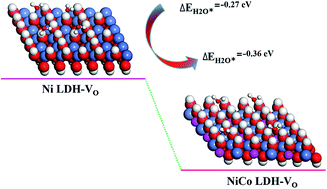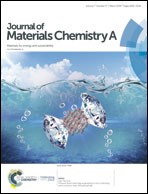Ni–Co hydroxide nanosheets on plasma-reduced Co-based metal–organic nanocages for electrocatalytic water oxidation†
Abstract
Development of highly efficient and low-cost electrocatalysts for the oxygen evolution reaction (OER) with high electrical conductivity and chemical stability is critical for various energy conversion devices and systems, yet still remains a formidable challenge. Herein, we develop a novel porous 3D hybrid nanostructure decorated with nickel cobalt layered double hydroxides (NiCo LDHs) on the surface of the functional ZIF-67 template with rich oxygen vacancies (VO) etched by O2–Ar radio frequency (RF) plasma. The as-prepared NiCo LDH@ZIF-67-VO/NF hybrid materials exhibit excellent OER performance evidenced by the competitive potential of 1.52 V at the current density of 10 mA cm−2 in alkaline medium. Moreover, the Tafel slope of 58 mV dec−1 is much lower compared to that of noble metal oxide and other counterpart catalysts. Our experimental and theoretical calculation results reveal that incorporation of VO into the NiCo LDH@ZIF-67-VO/NF composite can efficiently tune the electronic structure and also increase the water adsorption energy, ultimately accelerating the OER process. The work presents a novel strategy for designing highly efficient composite electrode materials with rich oxygen vacancies for the effective, scalable electrocatalytic water oxidation.



 Please wait while we load your content...
Please wait while we load your content...